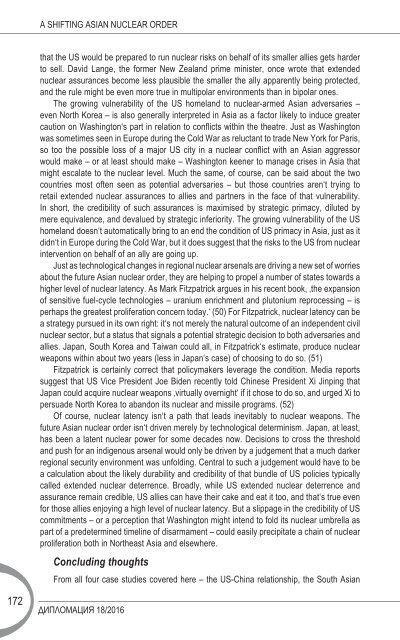DIPLOMACY ДИПЛОМАЦИЯ
2kGfdFv
2kGfdFv
You also want an ePaper? Increase the reach of your titles
YUMPU automatically turns print PDFs into web optimized ePapers that Google loves.
A SHIFTING ASIAN NUCLEAR ORDER<br />
that the US would be prepared to run nuclear risks on behalf of its smaller allies gets harder<br />
to sell. David Lange, the former New Zealand prime minister, once wrote that extended<br />
nuclear assurances become less plausible the smaller the ally apparently being protected,<br />
and the rule might be even more true in multipolar environments than in bipolar ones.<br />
The growing vulnerability of the US homeland to nuclear-armed Asian adversaries –<br />
even North Korea – is also generally interpreted in Asia as a factor likely to induce greater<br />
caution on Washington’s part in relation to conflicts within the theatre. Just as Washington<br />
was sometimes seen in Europe during the Cold War as reluctant to trade New York for Paris,<br />
so too the possible loss of a major US city in a nuclear conflict with an Asian aggressor<br />
would make – or at least should make – Washington keener to manage crises in Asia that<br />
might escalate to the nuclear level. Much the same, of course, can be said about the two<br />
countries most often seen as potential adversaries – but those countries aren’t trying to<br />
retail extended nuclear assurances to allies and partners in the face of that vulnerability.<br />
In short, the credibility of such assurances is maximised by strategic primacy, diluted by<br />
mere equivalence, and devalued by strategic inferiority. The growing vulnerability of the US<br />
homeland doesn’t automatically bring to an end the condition of US primacy in Asia, just as it<br />
didn’t in Europe during the Cold War, but it does suggest that the risks to the US from nuclear<br />
intervention on behalf of an ally are going up.<br />
Just as technological changes in regional nuclear arsenals are driving a new set of worries<br />
about the future Asian nuclear order, they are helping to propel a number of states towards a<br />
higher level of nuclear latency. As Mark Fitzpatrick argues in his recent book, ‘the expansion<br />
of sensitive fuel-cycle technologies – uranium enrichment and plutonium reprocessing – is<br />
perhaps the greatest proliferation concern today.’ (50) For Fitzpatrick, nuclear latency can be<br />
a strategy pursued in its own right: it’s not merely the natural outcome of an independent civil<br />
nuclear sector, but a status that signals a potential strategic decision to both adversaries and<br />
allies. Japan, South Korea and Taiwan could all, in Fitzpatrick’s estimate, produce nuclear<br />
weapons within about two years (less in Japan’s case) of choosing to do so. (51)<br />
Fitzpatrick is certainly correct that policymakers leverage the condition. Media reports<br />
suggest that US Vice President Joe Biden recently told Chinese President Xi Jinping that<br />
Japan could acquire nuclear weapons ‘virtually overnight’ if it chose to do so, and urged Xi to<br />
persuade North Korea to abandon its nuclear and missile programs. (52)<br />
Of course, nuclear latency isn’t a path that leads inevitably to nuclear weapons. The<br />
future Asian nuclear order isn’t driven merely by technological determinism. Japan, at least,<br />
has been a latent nuclear power for some decades now. Decisions to cross the threshold<br />
and push for an indigenous arsenal would only be driven by a judgement that a much darker<br />
regional security environment was unfolding. Central to such a judgement would have to be<br />
a calculation about the likely durability and credibility of that bundle of US policies typically<br />
called extended nuclear deterrence. Broadly, while US extended nuclear deterrence and<br />
assurance remain credible, US allies can have their cake and eat it too, and that’s true even<br />
for those allies enjoying a high level of nuclear latency. But a slippage in the credibility of US<br />
commitments – or a perception that Washington might intend to fold its nuclear umbrella as<br />
part of a predetermined timeline of disarmament – could easily precipitate a chain of nuclear<br />
proliferation both in Northeast Asia and elsewhere.<br />
Concluding thoughts<br />
From all four case studies covered here – the US-China relationship, the South Asian<br />
172<br />
<strong>ДИПЛОМАЦИЯ</strong> 18/2016


